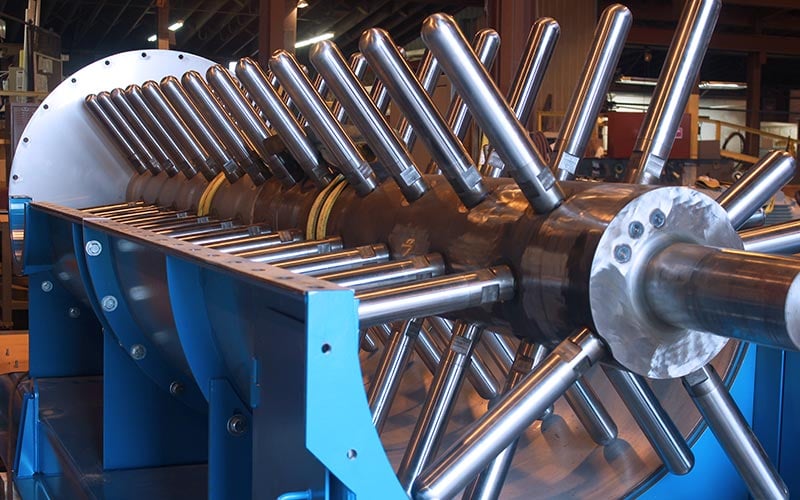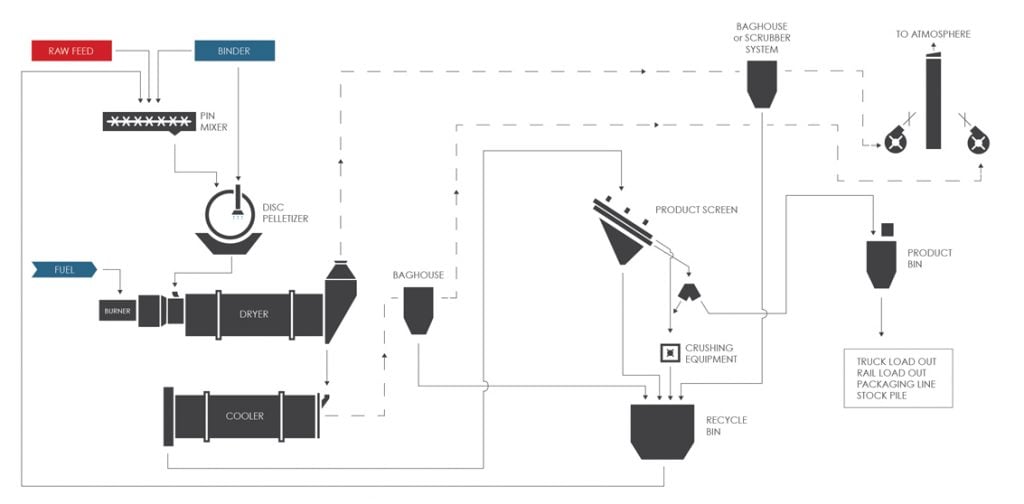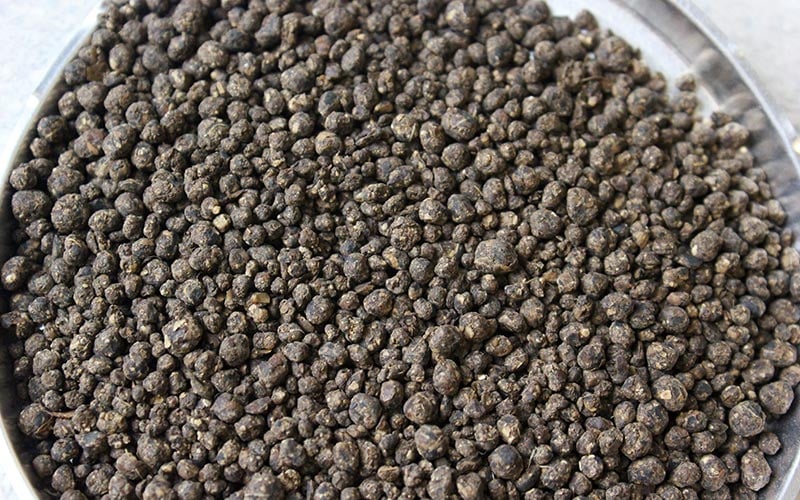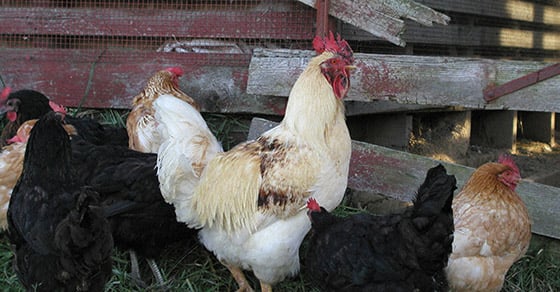As farms have evolved into ever-larger concentrated animal feeding operations (CAFOs), waste management has become increasingly challenging. Poultry producers are finding that granulation can offer a new approach to managing on-farm wastes that not only solves their waste management challenges, but brings with it a number of benefits as well.
The Need for Chicken Manure & Litter Granulation
The challenges associated with managing large amounts of animal waste, in this case poultry litter and manure, have become increasingly evident in recent years, with waterways all over the United States experiencing eutrophication, or dead zones, tied to nutrient run-off largely attributed to agricultural sources.
While some producers may have the opportunity to land apply their waste, this is often not an option, due to a lack of available land, the cost of transporting material, risk of runoff, or other factors.
As a result, meat (broiler) and egg (layer) producers are faced with rising amounts of waste and fewer options for management. By granulating their waste, however, producers can solve their waste management challenge and minimize the potential for nutrient runoff all at once.
How Granulation Solves the Problem
Granulation resolves waste management challenges, reduces nutrient runoff, and opens a host of new opportunities to poultry producers in a few key ways:
More Efficient Application
Because granules are a dry, flowable product, handling and application are significantly improved.
Especially during the winter months, raw chicken manure can have a high moisture content, making it difficult to work with. It can also encourage land-applied nutrients to be carried away more easily. In contrast, chicken litter does not have a high moisture content, but can be dry and dusty, making it challenging to handle and prone to becoming windblown.
Transforming either material into a granular product significantly improves handling and application by creating a more manageable and flowable product.
Granules also make it easier to follow a nutrient management program, particularly when precision agriculture comes into play. This is because it is much easier to accurately meter and apply the prescribed amount of nutrients.
For these reasons, runoff is less likely to occur and growers are able to avoid windblown nutrients, instead realizing the full nutrient value of their application.
Reduced Transportation Costs = Greater Distance From the Farm
In the case of converting a wet manure, the reduced shipping costs made possible because of a dry product mean that the nutrient can be transported further away from the farm, opening up greater opportunities for use and sale.
A Stable, Storable Product
Unlike manure or litter, a dry granular product is stable and can be stored and used as needed.
A Premium Product
The granulation process gives producers more control over their nutrient source; in addition to the benefits above, a granular product is considered a premium fertilizer product and can be sold as such. Producers have the option to incorporate additional nutrients and beneficial additives to improve the product’s value, as well as control a number of granule specifications to tailor the product to its intended target audience.
An Alternative to Extrusion
Historically, many producers have looked to extrusion to transform their manure or litter into a granular product.
Extrusion is a method of pressure agglomeration that works by forcing material through a die to produce a cylindrical product. The resulting product can be used as-is, or processed further into irregularly shaped granules.
While this approach is a step in the right direction, it is not without issue; the crumbles produced from the extrusion process have rough edges that break down easily into fines, causing severe dust issues and product loss.
Additionally, the highly abrasive quality so typical of chicken waste is hard on the equipment used in the extrusion process, resulting in high maintenance costs associated with frequent die replacement.
In contrast, FEECO recommends the non-pressure approach (also known as wet granulation, tumble-growth agglomeration, or agitation agglomeration). This method of granulation produces a smooth, spherical granule that greatly improves upon the usability of the product. Spherical granules are significantly less dusty, ultimately yielding more usable product, as well as improved handling and application.
How Chicken Litter & Manure Granulation Works
Pre-Conditioning
Whether working with raw manure or litter, some preconditioning is necessary to prepare the material for granule formation:
Moisture Reduction
Raw manure is typically too wet or clumpy to serve as a uniform feedstock (moisture content should be below 15%), so before it can be granulated, it must first go through some type of moisture reduction. Various options exist.
Composting is one technique used to reduce moisture content and clumps in the material. However, this is not always ideal, because the composting process converts the organic nitrogen in the product into ammonia nitrogen, making it more susceptible to volatilization and ultimately devaluing the product.
Another option is to dry the material through dewatering, or drying via solar, belt dryer, or pad drying.
Chicken litter does not typically require a pre-drying step, but may in cases exhibiting a higher moisture content.
Grinding
Both manure and litter require a grinding step prior to granulation (FEECO recommends particles are less than 35 mesh). Grinding in a hammer mill creates a more uniform particle size distribution and reduces particle size for optimal granule formation.
Mixing and Seed Pellet Formation
Once a uniform feedstock has been created, the granulation process can begin.

Interior of pin mixer (cover removed for photo)
First, the feedstock and a liquid binder are fed into a mixer continuously. This is typically a pin mixer, which is more adept at handling finely divided solids. The intense spinning action of the mixer, in combination with the binding agent, densifies and begins to agglomerate the material as it moves through the mixer. The newly formed seed pellets then exit the mixer and are fed onto a disc pelletizer.
Pellet Growth
On the disc pelletizer, binder is continuously sprayed onto the seed pellets as they tumble along with the disc’s rotation, picking up fines as they go and creating additional layers. This causes the pellets to “grow” in size (this layering effect is known as coalescence). The tumbling action also helps to further round and refine granules.
Due to centrifugal forces, once granules reach the desired size, they exit the disc pelletizer and are carried via conveyor to a drying system.

Pellets on a disc pelletizer in the FEECO Innovation Center
Drying
The drying system may consist of a rotary dryer or fluid bed dryer.
Rotary dryers are ideal for high-capacity settings and have the added benefit of “polishing” granules as a result of the tumbling action it imparts onto granules. Flights or material lifters pick up the granules and drop them through the gas stream to maximize heat transfer efficiency (for this reason, achieving a good “green strength” prior to drying is important).
Fluid bed dryers offer an ideal solution for smaller-capacity facilities. In this type of dryer, granules are fluidized in an enclosed vessel by passing heated air through a perforated distributor plate at a predetermined velocity.
Screening & Cooling
Depending on the process, granules can then either move on to screening or cooling in a rotary cooler. Cooling is desirable when granules will be packaged or stored right away, as it reduces the potential for caking.
Upon screening, over-size granules are crushed and combined with under-size granules to be fed back into the process as recycle. On-size granules move on to packaging, transport, or storage.
This approach to granulation is illustrated in the flow diagram below.

Typical process flow diagram for chicken manure or litter granulation
While other approaches to non-pressure granulation are available, the use of a disc pelletizer adds an element of product refinement not found in other methods of granulation.
The process is also highly customizable; various minerals and additives can be included to create custom fertilizer blends and formulations. Product characteristics are also customizable, but in general, bio-based granules produced via this process tend to be 2-4 mm, with a bulk density of around 30-35 lbs/cu. ft. and a crush strength of 3-5 lbs. Moisture content is ideally below 10%.

Chicken litter fertilizer granules produced using the pin mixer-disc pelletizer approach to granulation
Chicken Litter Granulation: A Case Study
This type of granulation has been successfully demonstrated in the Chesapeake Bay area, which is responsible for the majority of broiler production in the United States. The area has long been in the spotlight for its dense poultry operations and the resulting excess nutrient issues in the Chesapeake Bay.
A large agri-business producing broilers in the region had an existing extrusion facility, but was facing significant challenges and approached FEECO to find a solution.
The company’s centralized chicken litter recycling center served the region through drying the litter, extruding it into a pelleted form, and creating a sellable lawn and garden product for companies along the east coast. However, the company was facing two major problems that threatened to make the facility less viable.
The first issue they encountered was due to the sand mixed in with the litter; the feed was causing a lot of abrasive wear on the machines. The cost to perform maintenance on these machines consumed a large portion of their profit margin.
The second issue they ran into was the amount of attrition, or product breaking down into fines and dust, their product was exhibiting. Attrition presents its own set of challenges, resulting in a dusty product that not only causes product loss, but is also difficult to handle and apply and has a poor market perception.
The company was familiar with FEECO and our success with pelletizing and granulating problem materials and transforming them into valued-added products. They approached us looking for a solution.
We began by conducting batch-scale granulation tests in the FEECO Innovation Center.
This helped to establish the material’s behavior in response to non-pressure granulation. After successfully demonstrating proof of concept, we conducted a series of continuous trials with pin mixers and disc pelletizers to ensure that we could achieve these results reliably on a continuous basis. The spherical pellet yielded by the process was exactly what the customer was looking for.
Upon completion of test work, FEECO engineered and manufactured a pilot plant facility where the chicken litter could be transformed into premium fertilizer granules. The facility now processes roughly 7,500 to 15,000 tons of chicken litter per year into 5,000 to 10,000 tons of fertilizer per year.
This new process solved three problems for the company:
- Since the FEECO granulation method does not rely on extrusion technology, the facility experienced significantly less wear on their equipment, lowering their maintenance costs.
- The spherical pellets created were significantly less dusty, resulting in reduced product loss, cleaner handling and application, and ultimately, improved market perception.
- The spherical shape allowed the pellet to be easily blended with other types of fertilizers to make various fertilizer blends, something that the previous extrudates were not capable of.
Conclusion
With concentrated chicken farms and subsequent waste on the rise, a solution is needed that will not only alleviate waste management issues, but one that will also take advantage of the valuable nutrients contained within.
The granulation of chicken litter and manure into premium fertilizer products looks to be an all-encompassing solution. FEECO International has been serving the fertilizer industry since 1951, supplying custom granulation systems and equipment to companies around the world, all backed by process development testing and a comprehensive parts and service program. For more information on our granulation systems, contact us today!



